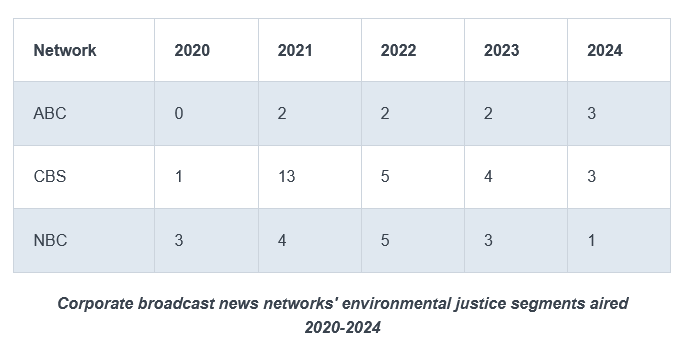The Decline Of Environmental Justice News Coverage
COOPER | Media Matters
Corporate broadcast news coverage of environmental justice declined in 2024.
ABC, CBS, and NBC aired a combined total of just 7 environmental justice segments, compared to 9 such segments in 2023. This continues a multiyear trend of declining airtime dedicated to stories about how environmental racism, economic exploitation, and environmental degradation disproportionately harm vulnerable communities.
Environmental justice refers to the disproportionate impact of environmental harms — such as air and water pollution, toxic exposure, or policy neglect — on communities that are already socially or economically marginalized. These include Black, Latino, Indigenous, and low-income populations that are more likely than other groups to live near industrial facilities, aging infrastructure, or fossil fuel extraction sites and bear the brunt of pollution to the air, land, and water.
Key Findings
From January 1 through December 31, 2024, corporate broadcast networks — ABC, CBS, and NBC — aired a total of 7 segments about environmental impacts, regulations, or health hazards that included a mention of a socially marginalized community. This marks a continued decline from 9 such segments in 2023 and 12 in 2022.
CBS and ABC each aired 3 environmental justice segments in 2024 while NBC aired just 1.
PBS News Hour aired 11 environmental justice segments in 2024, which is more than the combined total from the three corporate broadcast networks. Weeknight and weekend episodes of PBS News Hour were reviewed for comparison but are not included in the segment total.
Corporate broadcast networks also failed to cover several major environmental justice stories, including the water funding crisis in Jackson, Mississippi; the Supreme Court’s decision to halt EPA ozone protections; ongoing pollution monitoring failures along the Houston Ship Channel; and the growing barriers to black lung compensation in Kentucky.
How Corporate Broadcast Networks Covered Environmental Justice In 2024
In 2024, corporate broadcast networks aired just 7 segments about environmental impacts, regulations, or health hazards that also identified how those issues affected a socially marginalized community. This continues a multiyear trend of declining environmental justice coverage.
CBS and ABC each aired 3 environmental justice segments in 2024; NBC aired 1.
What Environmental Justice Coverage Looked Like In 2024
Most of the 7 qualifying segments that aired in 2024 focused on long-standing crises, with limited attention given to newer or escalating issues. One segment featured remarks from Chelsea Clinton at an environmental justice event highlighting the disproportionate impacts of extreme heat and pollution on low-income families, communities of color, and Indigenous populations. Another examined elevated asthma rates and property devaluation in neighborhoods near major highways. Other segments covered lead contamination in drinking water and chemical exposure in industrial corridors.
What A Second Trump Administration Means For Environmental Justice And What Broadcast Networks Must Do Now
Thirty years of environmental justice policy, including advances in environmental justice, have been dismantled in a matter of months. Since January 2025, the EPA’s Office of Environmental Justice has been eliminated, and billions in environmental justice grants have been rescinded or frozen. Oil and gas permitting has expanded in communities previously protected by environmental justice screening tools — tools designed to assess cumulative pollution burdens and demographic risk factors — and the broader federal regulatory framework is being reshaped under Project 2025, a blueprint designed to reduce the government’s capacity to track, regulate, or respond to cumulative environmental harm.
These changes are already weakening core protections for communities that have long borne the brunt of pollution to their air, land, and water, such as when the EPA and Department of Justice abandoned a case asserting that a synthetic rubber plant posed an immediate threat to residents in Cancer Alley. The elimination of federal accountability mechanisms makes it harder for residents to challenge hazardous permitting decisions, access public health data, or secure basic investments in safe infrastructure. Without sustained media scrutiny, these shifts will continue to proceed largely beyond public view.
READ MORE HERE …
EVLONDO COOPER is a Senior Writer with the climate and energy program at Media Matters.






